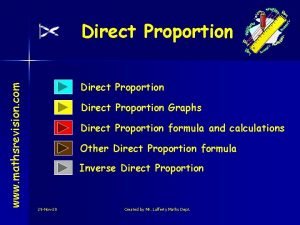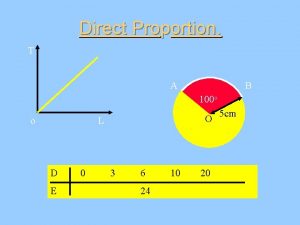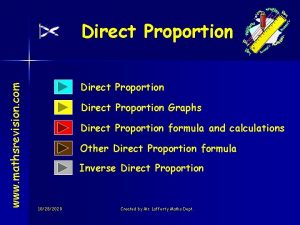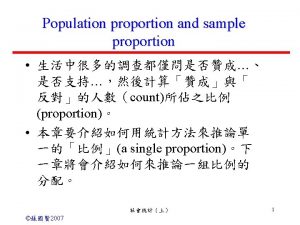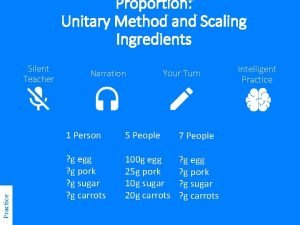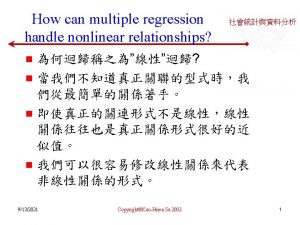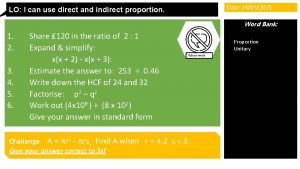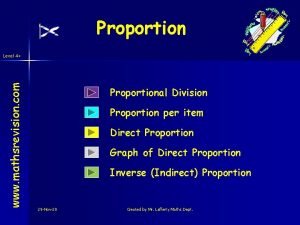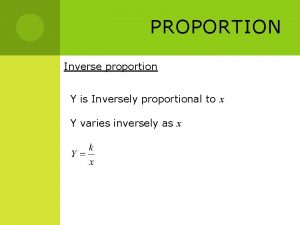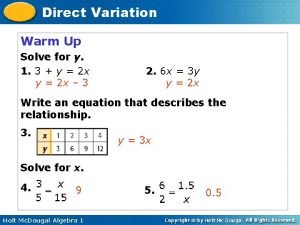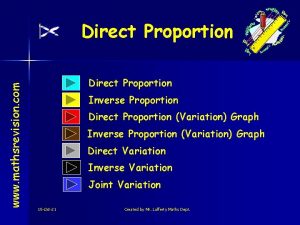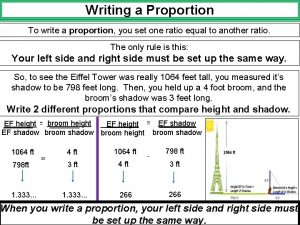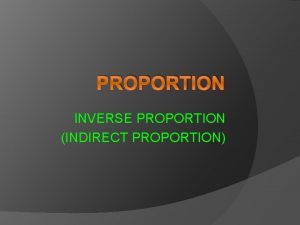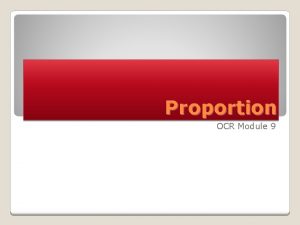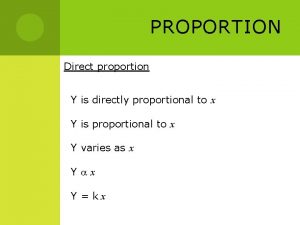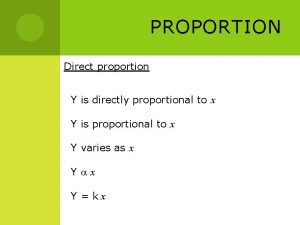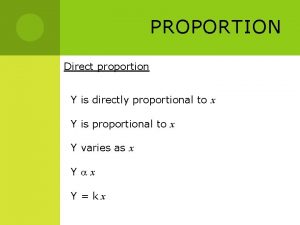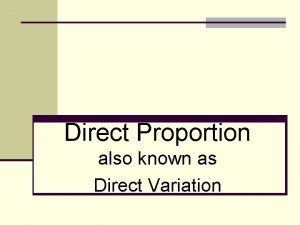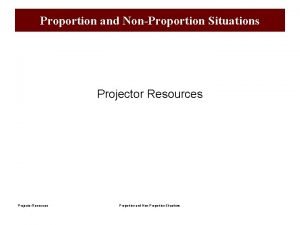Unit 7 Direct Proportion n 87 Direct Proportion





















- Slides: 21

Unit 7: Direct Proportion n #87 Direct Proportion Notes

IT / NOT IT n One person in your group is the recorder n Everyone will look at the IT / NOT IT and decide why you think makes it is “IT” or “NOT IT” n Write your finding on the paper.

Direct Proportion also known as Direct Variation

Consider this: On Friday chicken biscuits are sold before school. 1. Complete the chart to the right. What number do you think should go in the “? ” column? How do you know? $2. 50, because every biscuit costs $2. 50. 2. # of biscuits 1 2 5 times =Total cost ?

Direct Proportion Defined: The relationship between 2 quantities where one quantity changes based on what happens to the other quantity.

Direct Proportion n Look at the BISCUIT table. n Does the cost per biscuit change? no – it is always $2. 50 n What affects the total cost? the # of biscuits n The number of biscuits determines the total cost. n The number of biscuits is “x” and the total cost is “y”. n What equation could we write to represent the total cost of the biscuits? y = 2. 50 x

Direct Proportion: Equations n The cost of the biscuits is the same no matter how many you purchase. n Each time the number of biscuits changes, it changes by the same amount…. $2. 50 per biscuit. It is the constant of proportionality. (k) y = 2. 50 x Constant of Proportionality (AKA: unit rate) n n All equations in a direct proportion are in the form y = k x

Direct Proportion : Equations IS a DIRECT VARIATION NOT! y = 3 x +1 y=x y = x-1 y=½x or y = 1000000 x y=x/2 y=x+3 y = 3/x What is the constant of proportionality for each of these equations?

Direct Proportion : Graphs n Look at the graph at the bottom of your notes n Take 5 minutes to work with your shoulder partner to graph the biscuit table n What do you notice about your graph?

Direct Variation and its graph Observations: 1. the graph will always be a straight line 2. The graph will always go through…

the ORIGIN!!!!! (0, 0) Special point known as the “ORIGIN”

Tell if the following graph is a Direct Variation or not. No No Yes No

Tell if the following graph is a Direct Variation or not. No Yes No


Direct Proportion: Tables n Spend 5 minutes completing the X-Men Rock! Table. n How did you know what to put for y values?

direct proportion : the table People (x) Total Cost (y) 3 $30 5 $50 9 $90 Notice… • As x increases in value, y increases by the same factor …. This “same factor” is the constant of proportionality. You can find the constant of proportionality k by using k = y/x

Is it a Direct Proportion? Note, x increases: 6 , 7 , 8 and y increases: 12, 14, 16 • Is it a direct proportion? • Find the constant of proportionality for each row using k =y/x. k = 12/6 or 2 The constant of proportionality in the table above is 2. If all the values are the same it is a Direct Proportion The equation would be y=2 x

Is this a direct variation? If yes, give the constant of variation (k) and the equation. Yes! k = 10/20 or ½ k= 9/18 or ½ k= 7/14 or ½ k= 4/8 or ½ Equation? y = 1/2 x

Is this a direct variation? If yes, give the constant of variation (k) and the equation. k No! The k values are different!

Direct Proportion: Word Problems A car uses 8 gallons of gasoline to travel 280 miles. If the gas used and miles driven are proportional, how far will the car go on 10 gallons of gas? 25 gallons of gas? How many gallons are needed to drive 420 miles? 1. Spend 5 minutes with your shoulder partner completing the table from the word problem. 2. What is the constant of proportionality? 3. What equation would represent the scenario? 4. What would the graph look like?

x gallons used 8 y miles driven 280 10 350 25 875 12 420 2. constant of proportionality k = 35 3. equation: y = 35 x 4. a straight line through the origin k = y/x 280/8= 35 10 x 35 = 350 25 x 35 = 875 35 x= 420 x=12
 Unit 6 review questions
Unit 6 review questions Quiz 1: ratios, properties, and proportions
Quiz 1: ratios, properties, and proportions Direct proportion
Direct proportion Variation and proportion
Variation and proportion Direct proportion calculator
Direct proportion calculator Inverse proportion graph examples
Inverse proportion graph examples Dr frost direct and inverse proportion
Dr frost direct and inverse proportion How to do direct proportion
How to do direct proportion Direct and inverse proportion graphs worksheet
Direct and inverse proportion graphs worksheet Direct proportion formula
Direct proportion formula Ratio and direct proportion
Ratio and direct proportion Silent night unitary
Silent night unitary Ratio and direct proportion
Ratio and direct proportion Proportion direct and indirect
Proportion direct and indirect Proportional division example
Proportional division example Direct and inverse proportion activity
Direct and inverse proportion activity Y is inversely proportional to square root of x
Y is inversely proportional to square root of x Direct proportion
Direct proportion Direct proportion formula
Direct proportion formula Metode pembiayaan semi langsung
Metode pembiayaan semi langsung How to label hyp opp adj
How to label hyp opp adj English system of measurement
English system of measurement


